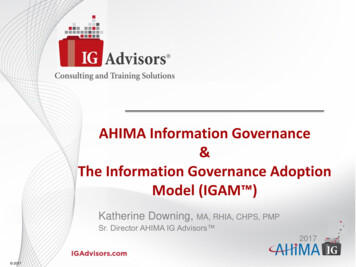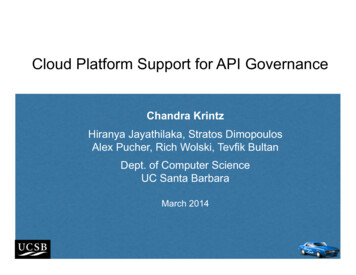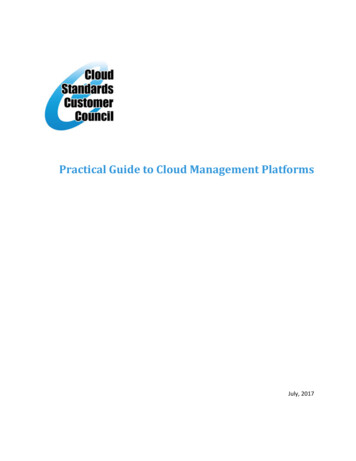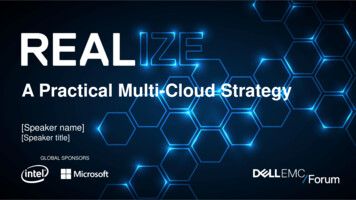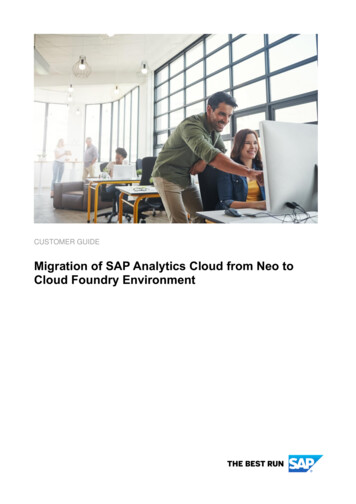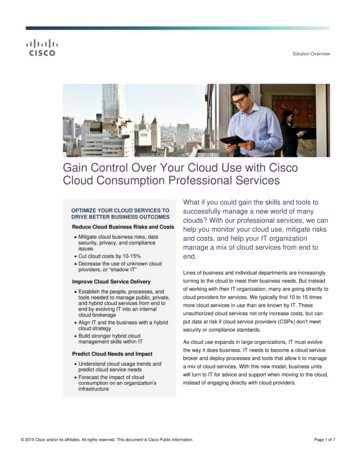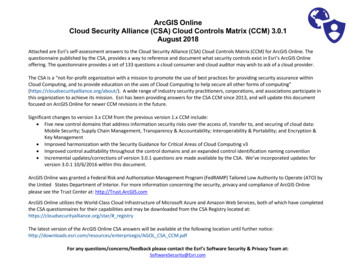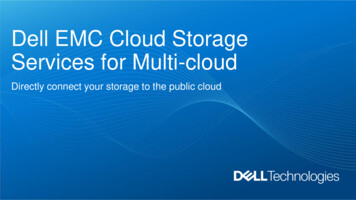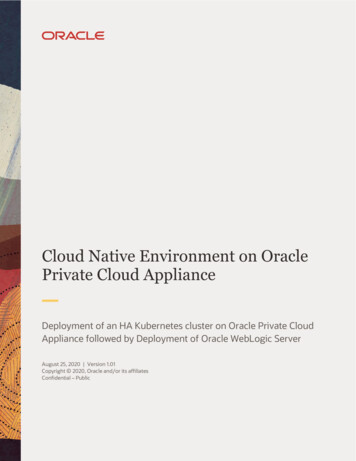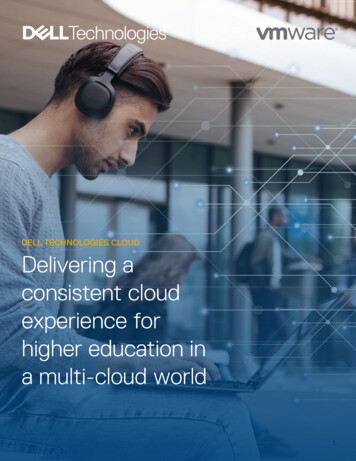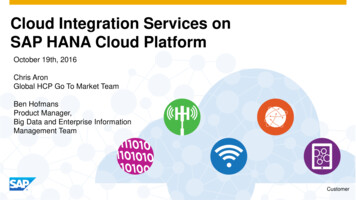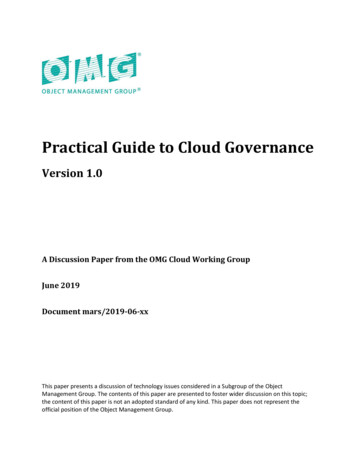
Transcription
Practical Guide to Cloud GovernanceVersion 1.0A Discussion Paper from the OMG Cloud Working GroupJune 2019Document mars/2019-06-xxThis paper presents a discussion of technology issues considered in a Subgroup of the ObjectManagement Group. The contents of this paper are presented to foster wider discussion on this topic;the content of this paper is not an adopted standard of any kind. This paper does not represent theofficial position of the Object Management Group.
This page intentionally left blankCopyright 2019 Object Management GroupPage 2
Table of ContentsAcknowledgements. 4Executive Overview . 5Step 1: Understand – What is Cloud Governance?. 6The Need for Cloud Governance. 7Case Studies for Cloud Governance . 7Step 2: Benchmark . 8Measure the Organization’s Governance Maturity . 8Benchmark for Business Agility . 11Using Cloud Governance to Measure the “Goodness” of Cloud . 12Step 3 – Establishing a Cloud Governance Framework . 16Review of IT and Cloud Governance Models and Frameworks . 16Leveraging Existing Cloud Governance Models and Frameworks . 18A Suggested Cloud Adoption Governance Framework. 18Step 4 – Cloud Governance Alignment . 21Step 5 – How to Establish A Cloud Governance Program . 21Cloud Governance Charter and Operation . 22Cloud Governance Program Roles and Responsibilities . 22Minimum Activities to Stand up and Operate a Cloud Governance Program . 23Step 6 – Establishing Governance Measures and Related Metrics. 25Step 7 – How do you sustain success? . 30References . 31Bibliography . 31Standards and Governance Organizations. 32Other References . 33Appendix: Governance Use Cases, Objectives and Outcomes . 34Copyright 2019 Object Management GroupPage 3
2019 Cloud Standards Customer Council. All rights reserved. You may download, store, display onyour computer, view, print, and link to the Practical Guide to Cloud Governance white paper at the OMGCloud Working Group Web site, subject to the following: (a) the document may be used solely for yourpersonal, informational, non-commercial use; (b) the document may not be modified or altered in anyway; (c) the document may not be redistributed; and (d) the trademark, copyright or other notices maynot be removed. You may quote portions of the document as permitted by the Fair Use provisions of theUnited States Copyright Act, provided that you attribute the portions to the OMG Cloud Working GroupPractical Guide to Cloud Governance (2019).AcknowledgementsDevelopment of the Practical Guide to Cloud Governance is a collaborative effort that brings togetherdiverse customer-focused experiences and perspectives into a single guide for cloud customers. Thefollowing participants contributed significant expertise and time to this effort: Karolyn Schalk (IBM) – editorClaude Baudoin (cébé IT & Knowledge Management)Christian Boudal, (IBM)Jyoti Chawla (IBM)Jean-Claude Franchitti (Archemy)Shashank Heda (Wipro)Nya Allison Murray (Trac-Car)Osai Osaigbovo (IBM)Mick Talley (University Bank)Katy Warren (Mitre)Thanks to our other contributors: Ahmed Abdelaziz (IBM), Manish Bhatia (Wipro), Frank Chin(iTGRC), Fernando García Velasco (IBM), Maunang Mehta (Thomson Reuters), Kumail Morawala, SumitPatel (IBM), Balaji Ramarajan (Cognizant), Anantha Rao (Wipro), Hariprasad Sasidharan V (Wipro), KarlScott (Satori Consulting), Prasad Siddabathuni (Edifecs), Ajai Srivastava (Seven Step Consulting), WisnuTejasukmana (Schlumberger), Veera Venigalla (T-mobile), and John Wooten (consultED).Copyright 2019 Object Management GroupPage 4
Executive OverviewGovernance is a loaded word. It can evoke negative responses and is often incorrectly defined asstrategy, policy or procedure. Misconceptions about what governance is, the level of effort needed toset up a program, and how it supports day-to-day operations may be the greatest barriers to anorganization embarking on this necessary work.The results of good governance are measurable; some studies show that organizations with aboveaverage IT governance have over 20% higher profits than those with inadequate governance followingan otherwise similar IT strategy [1]. The importance of governance in ensuring successful, sustainableadoption of cloud computing and cloud services has been discussed in previous OMG Practical Guidesand Publications, including the 2018 Best Practices for Developing and Growing a Cloud-EnabledWorkforce [2], the 2016 Practical Guide to Hybrid Cloud Computing [3], and many others. What theseguides will not do is offer specific guidance on how to plan and launch a governance program based onyour specific needs. This publication fills this gap.The Practical Guide to Cloud Governance is written to help IT executives and their counterparts in theC-suite and lines of business speak to one another as they embark on cloud transformation. Cloudgovernance demands a greater focus on business architecture, in the same way that successful cloudadoption is dependent on close alignment with business goals and strategy. Related organizationalchanges can be as challenging as the technical because: The shared services model of the cloud is new to many organizations and requiresstandardization of approach. Subscription and pay-as-you-go purchase models make new budgeting and financial strategies anecessity. IT is no longer the sole owner of the technology service portfolio; IT advises the business andhelps it innovate. Staff manage services and Cloud Service Providers (CSPs) instead of assets. In addition to technical complexities, staff will have to navigate new operating models. The velocity of change increases by orders of magnitude, demanding agile organizationalmethods and capabilities.Cloud governance is not a “one and done” activity. To keep up with innovations in technology andbusiness models, governance must be reviewed and maintained. The seven-step approach werecommend (see Figure 1) will serve you well throughout the lifecycle of your program. It can befollowed asynchronously, the ability to execute several steps in parallel allowing you to move aheadefficiently.Copyright 2019 Object Management GroupPage 5
Figure 1 -- Seven Evolutionary Steps to Execute and Sustain Cloud GovernanceStep 1: Understand – What is Cloud Governance?Governance, generically, may be defined as an agreed-upon set of policies and standards, which is: based on a risk assessment and an-agreed upon framework,inclusive of audit, measurement, and reporting procedures, as well as enforcement of policiesand standards.In a multi-enterprise or multi-platform cloud environment, participants agree to promote and establishjoint expectations for security and service levels. Governance will also define the process for anyresponse to a breach of protocol, and the set of decision makers who are responsible for mitigation andcommunication.COBIT 5 [4], ISACA’s framework for enterprise IT governance and management, succinctly andeffectively illustrates the fundamental differences and the feedback loops necessary for a successfulprogram.Figure 2 – Governance vs. ManagementCopyright 2019 Object Management GroupPage 6
The Need for Cloud GovernanceThe introduction of cloud computing into an organization affects roles, responsibilities, processes andmetrics. Without cloud governance in place to provide guidelines to navigate risk and efficiently procureand operate cloud services, an organization may find itself faced with these common problems: Misalignment with enterprise objectivesFrequent policy exception reviewsStalled projectsCompliance or regulatory penalties or failuresBudget overrunsIncomplete risk assessmentsCase Studies for Cloud GovernanceThese anonymized case studies align with common high-level business and technical objectives, andillustrate why cloud governance is important. More granular governance use cases, applicable to specificprocesses used to plan, build and operate cloud-based solutions, are the Appendix.Digital TransformationCapybara Corp., a maker of custom sensor controls, initiated a major digital transformation project. Themain goals were to reduce the overall infrastructure cost by limiting what is maintained in their privatedata centers, reduce the cost of software development, and simplify adoption of cloud-services in areasof analytics and machine learning. Capybara was already using some IaaS and SaaS, and had insertedsome cloud guidance and controls into their financial and IT governance. The cloud guidance wasconfined to industry compliance and infrastructure standards. When different lines of businesssubmitted their candidates for migration to the CIO’s transition team, the wide variance in assessmentdata and rationales raised a red flag. Assessments did not uniformly provide the following information: Resource availability for development and application supportCapacity or growth forecasts for custom built applicationsPerformance benchmarkingData residency or privacy needsAvailability of test dataAssessment of the team’s skill set to support cloud migrationAs a result, the CIO recognized the need to enhance existing cloud governance to assure successfulmigrations. Guided by current governance and available data, Capybara had the confidence to beginsome transformation work in parallel with implementing new cloud governance controls: Non-critical, commercial productivity applications used within a single country and withcomplete assessment packets could migrate to a cloud infrastructure.Lines of business could move from traditional application licenses to SaaS for non-criticalapplications.Enterprise architecture and development groups could begin using PaaS as a sandbox to exploreanalytics and machine learning capabilities and contribute to the creation of internal standards.A new, high-level transformation plan was created that kicked-off new transformation workstreams asdraft cloud governance standards became available.Copyright 2019 Object Management GroupPage 7
ComplianceThe tax department of a major American city decided to migrate their system for collection,management and storage of tax forms from an on-premises solution, housed in a municipal data center,to a SaaS solution. This was the city’s first migration of a highly regulated system to the cloud. Tax formscontain information that is shared with the Internal Revenue Service (IRS). This Federal Tax Information(FTI) is managed according to IRS Publication 1075, which requires entities that handle FTI to submitattestation of controls 45 days ahead of bringing a new or changed system live. The migration projectteam waited until two weeks before their go-live date to engage their compliance officer in a controlsreview. As a result, the go-live was delayed by two months. Several governance gaps contributed to thisfailure: Project governance did not include requirement for compliance reviews throughout projectstages.Procurement reviews operated independently of IT and departmental reviews.The Compliance Office had not updated internal controls and guidance to include cloud services,and thus needed additional time to review the solution.The project team made an assumption that the controls for cloud were the same as for theircurrent solution.OverageXYZ Co., a mid-sized manufacturer of specialty electronics, acquired two smaller companies. XYZ uses avariety of cloud services to run their business, including an online order system, manufacturingexecution and quality systems which integrate into the business intelligence services used to providedaily operational reports. XYZ rapidly onboarded their new acquisitions into their primary systems. Thefi
Practical Guide to Cloud Governance (2019). Acknowledgements Development of the Practical Guide to Cloud Governance is a collaborative effort that brings together diverse customer-focused experiences and perspectives into a single guide for cloud customers. The following participants contributed significant expertise and time to this effort:
